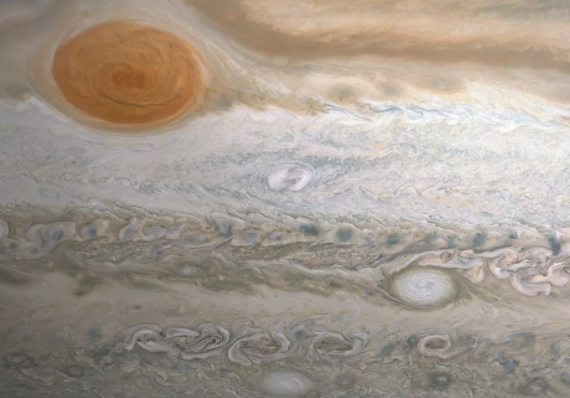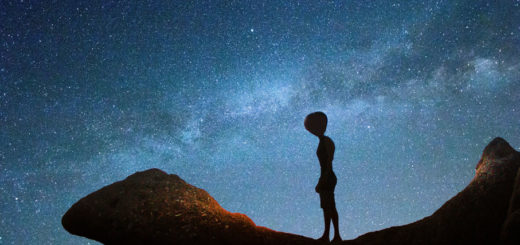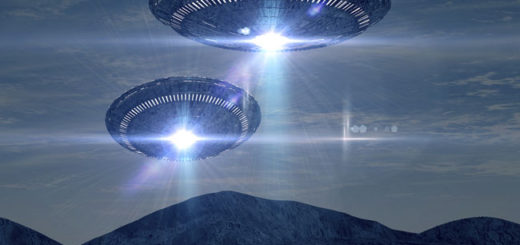Jupiter’s Great Red Spot may survive by gobbling up smaller storms

The most famous storm in the solar system is an apex predator.
Jupiter’s Great Red Spot feasted on numerous smaller storms that wandered into its neighborhood recently, possibly even gaining sustenance from these meals, a new study suggests.
Astronomers have been observing the Great Red Spot continuously since the late 19th century. The storm has shrunk considerably during that stretch, going from 25,000 miles (40,000 kilometers) wide in the 1870s to about 10,000 miles (16,000 km) wide today. (For perspective: Earth is a little more than 7,900 miles, or 12,700 km, across.)
Astronomers aren’t sure why the Great Red Spot is getting smaller. Some have speculated that collisions with smaller storms, which have increased in recent years, may play a role. The new study investigated that hypothesis.
Researchers led by Agustín Sánchez-Lavega, a professor of applied physics at the Basque Country University in Spain, studied images of the Great Red Spot captured between 2018 and 2020 by NASA’s Hubble Space Telescope, the space agency’s Jupiter-orbiting Juno spacecraft and amateur astronomers here on Earth.
The team identified numerous encounters between the Great Red Spot and smaller anticyclones. (Anticyclones swirl around central cores of high atmospheric pressure, whereas cyclones such as Earth’s hurricanes spin around regions of low pressure.) These atmospheric crashes chipped away at the Great Red Spot, peeling off cloud chunks around the big storm’s edges.
A flake of red peels away from Jupiter’s Great Red Spot during an encounter with a smaller anticyclone, as seen by the Juno spacecraft’s high resolution JunoCam on 12 February 2019. Although the collisions appear violent, planetary scientists believe they are mostly surface effects.
A flake of red peels away from Jupiter’s Great Red Spot during an encounter with a smaller anticyclone, as seen by the Juno spacecraft’s high resolution JunoCam on Feb. 12, 2019. Although the collisions appear violent, planetary scientists believe they are mostly surface effects. (Image credit: AGU/Journal of Geophysical Research: Planets)
The Great Red Spot’s diameter shrank as it gobbled up these smaller storms, the team found. But those changes were likely only skin-deep, “not affecting the full depth of the GRS [Great Red Spot],” Sánchez-Lavega and his colleagues wrote in the new study, which was published online Wednesday (March 17) in the Journal of Geophysical Research: Planets.
“The interactions are not necessarily destructive but can transfer energy to the GRS, maintaining it in a steady state and guaranteeing its long lifetime,” they added.
“This group has done an extremely careful, very thorough job,” Timothy Dowling, a professor of physics and astronomy at the University of Louisville who was not involved in the new study, said in a statement.
The flaking away of Great Red Spot material is likely just a surface phenomenon, leaving the storm’s depths, which extend 125 miles (200 km) beneath Jupiter’s cloud tops, largely untouched, Dowling added.



 Creators of mankind
Creators of mankind Description of “Tall white aliens”
Description of “Tall white aliens” Where they came from?
Where they came from? About hostile civilizations
About hostile civilizations The war for the Earth
The war for the Earth “Tall white aliens” about eternal life
“Tall white aliens” about eternal life Video: “Nordic aliens”
Video: “Nordic aliens” Aliens
Aliens Alien encounters
Alien encounters The aliens base
The aliens base UFO
UFO Technology UFO
Technology UFO Underground civilization
Underground civilization Ancient alien artifacts
Ancient alien artifacts Military and UFO
Military and UFO Mysteries and hypotheses
Mysteries and hypotheses Scientific facts
Scientific facts


















